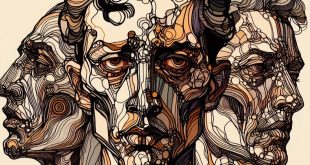
The importance of emotions and sensitivity in the relationship with art
Meeting Benches is a website that celebrates art in all its forms. It functions as a virtual meeting and inspirational place, where travelers, artists, thinkers and dreamers from all over the world can share art, travel stories and thoughts. You will find a variety of content, including articles on emerging and established artists, book reviews, poems, short stories and art galleries. In addition, Meeting Benches offers a section dedicated to the world of travel, where you can discover literary works and delve into writers such as Stendhal and his fascinating “La Certosa di Parma“. We propose this book that invites you to reflect on the psychological power of travel, intended as an experience that resonates with anyone who is particularly sensitive to the mysterious charm of beauty. Click above “Writers“, if you want to know more. The digital images accompanying this post were created by Dastilige Nevante.

“The Stendhal Syndrome“, a 1996 psychological thriller directed by Dario Argento, follows the adventures of a policewoman from the Roman anti-rape squad. She is sent by her superior to Florence to find a dangerous serial killer who has already raped and killed many women. In the film, that policewoman seems to have lost consciousness in the grip of “Stendhal Syndrome”, an intoxicating sensation caused by the strong emotions provided by the vision of works of art. Also known as “Florence Syndrome“, that psycho-somatic clinical manifestation that causes physical discomfort, occurs when the person is faced with works of art of great beauty. This phenomenon, called takes its name from the French writer of the same name, Stendhal, pseudonym of Marie-Henri Beyle, who first described the symptoms following a visit to the capital city of Florence. But who are the people most prone to experiencing this fascinating syndrome?

A lover of art and passionate about Italy, Stendhal made his literary debut with biographies of Haydn, Mozart, Metastasio and Gioachino Rossini, followed by a History of Painting in Italy and a romantic book about his travel memories in Rome, Naples and Florence. Celebrated for novels such as “The Red and the Black” and “The Charterhouse of Parma“, both marked by the search for the psychological characterization of the characters, Stendhal is currently considered one of the first exponents of French romantic realism of the 19th century. His young and romantic protagonists inevitably aspire to self-realization through the expansion of passionate feelings of love.

“Stendhal Syndrome” occurs when particularly sensitive people are faced with works of art or architecture of remarkable beauty. In scientific terms, this syndrome was first described by Graziella Magherini, an Italian psychoanalyst, in 1989. The name of this condition, which is particularly evident when works of art are located in limited spaces, comes from the experience described by the French writer Stendhal during his visit to the Basilica of Santa Croce in Florence: “I had reached that level of emotion where the celestial sensations given by the arts and passionate feelings meet. Leaving Santa Croce, my heart skipped a beat, life for me had dried up, I walked fearing I would fall.”

Regarding the psychosomatic alteration called “Stendhal Syndrome“, there is no specific scientific definition, but it is believed that it develops in response to something extraordinarily beautiful. Visual and architectural arts are the most common causes. Symptoms can be both mental and physical, and include tachycardia, dizziness, vertigo, confusion and even hallucinations. However, it should be noted that the syndrome is not listed as a recognized condition in the Diagnostic and Statistical Manual of Mental Disorders. Famous works of art that could trigger this syndrome? “Giotto’s frescoes in Santa Croce“, a case described by Stendhal himself. “Michelangelo’s David“, a famous sculpture exhibited in the Galleria Della Accademia in Florence, evokes intense reactions in visitors. Works inside the renowned “Museo degli Uffizi“, which houses masterpieces by Botticelli, Leonardo da Vinci and Raphael, can also have a significant emotional impact.

Given that “Stendhal Syndrome” is rare and that in most cases art is a positive and enriching experience, we offer you some tips to protect yourself from this syndrome, which is rare and does not affect everyone, during an art visit. Keep an open and relaxed mind, avoid visiting too many extraordinary works of art in a short period of time and take breaks between visits. Make sure to drink water and rest adequately, because tiredness can increase emotional sensitivity. To stay calm and reduce anxiety, focus on deep and conscious breathing. If you feel overwhelmed, look away for a moment, focus on less intense details or close your eyes. Sharing emotions can help you manage them better, so talk to other visitors or a tour guide.
 Meeting Benches World art in all forms
Meeting Benches World art in all forms







